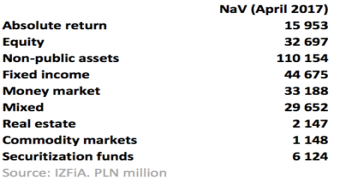Hedge funds in Poland
Asset management industry in Poland very seldom uses the phrase Polish hedge fund in its marketing. This does not mean Polish investors are not interested in this asset class nor is it non-existent in Poland. Let’s have a look at the $90 billion asset management market in the beautiful country by the Vistula river.
Polish asset management industry
According to the IZFA (Chamber of Asset Management Companies) in April 2017 Polish asset management companies (TFI) managed 275.739 million PLN of assets. Almost half of these were non-retail. The structure is presented below.

Most of the categories are straightforward. Let’s focus on Absolute return, which blends both regular UCITS funds and non-public closed funds. The latter is an interesting from the hedge funds perspective as it "pools capital from accredited individuals or institutional investors and invests in a variety of assets, often with complex portfolio-construction and risk-management techniques. It is administrated by a professional investment management firm…" (Wikipedia Hedge fund definition).

Some of the Polish absolute return funds category members certainly fall under the hedge fund definition, not to exclude us – Opoka TFI. The boom in this market began in 2011. Legal changes, which liberalized the law regarding non-public funds revolutionized the asset management market, which was then dominated by the global companies, affiliated with banks, insurance companies or asset management companies. Non-public funds called FIZ were since 2011 issued to classified investors and began new era of local asset managers. Offered only to max. 149 investors in single closed offer with a minimum of 40.000 EUR initial investment, FIZ boomed and in recent years took most of the growth of asset management market. Their investment mandate can be much broader than of open-ended funds, allowed risk limits are also higher.
Opoka TFI
Opoka TFI was one of the asset management companies described in the previous section. Founded in 2007, we manage only closed non-public funds – both in public and non-public assets. Our absolute return funds provide stable and positive results in every calendar year since our first fund Opoka One for 3rd party investors launched in 2010.

Risk management
- We always think about the risk
- Each investment decision is based on potential gains confronted with the risk we can take
- Low liquidity of an asset is a key risk factor for us
Analytical work
- We express independent opinions and think as an individual investor, not a corporation
- We prefer fundamental analysis when analyzing single stocks
- We use intermarket, sentiment and technical analysis when trading other instruments
Absolute return
- Generated for every market conditions
- Non-correlated with benchmarks
- Based on liquid assets listed on public markets
We are the privately-owned company which has a longest absolute return track record in Poland. Our team consists of 5 portfolio managers (hyperlink do strony o nas) with specialty in local equities, commodity markets and global equity indices.
Today our offer consists of 5 funds.
- Opoka One – Absolute return, multi asset fund launched in 2010. Currently closed for new business
- Opoka Neutral – Long-short equity fund launched in 2014, speculates mostly in Polish Large and Midcaps. Currently soft-closed (for new business from distributors)
- Opoka Alfa – Absolute return, multi asset fund launched in 2015 as a very similar strategy to Opoka One. Portfolio consists of Polish equities (long/short), gold ETFs with active allocation and portfolio of futures
- Opoka Ultra – Absolute return, multi asset fund launched in 2015. Ultra allows more risk than Opoka Alfa.
Opoka Quant – launched in 2017 fund uses various algorithms to support the management of the fund. Algorithms created by Grzegorz Link and Maciej Żukowski are trading observations written down as a code and tested in real life instead of finding quantative relationships from the past and believing they will work well in the future.
Should you have any questions regarding our offer please contact the Author of this article.



